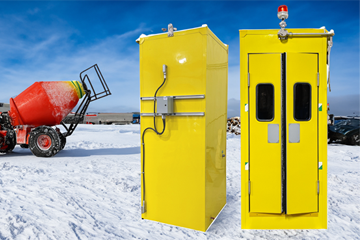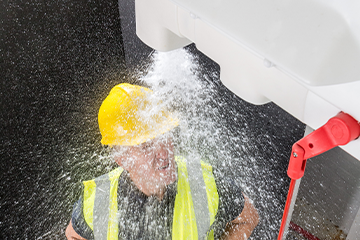Enquiry List () (0)
- Jan 11, 2024
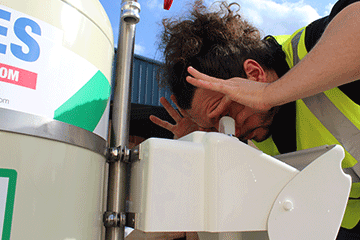
What are the OSHA Safety Shower Requirements?
Ten seconds. That’s about the same amount of time that it takes to tie your shoelaces or to fold a t-shirt. According to the Occupational Safety and Health Association (OSHA), that’s also the longest it should take anyone to reach a safety shower if they are splashed with a hazardous chemical.
OSHA’s regulators set these standards to make sure workers can receive immediate relief from chemical burns and other workplace safety hazards. But, these are not just recommended guidelines. OSHA has no issues with enforcing its regulations through fines. In fact, the organization increase their maximum penalties every January. Willful violation of OSHA rules or standards can cost companies over $156,000 in fines. A record number of violations at a refinery resulted in fines of more than $81M after an oil spill! With hazard communication failures being the second most reported violation to OSHA in 2023, chemical hazards could be costly when overlooked.
Ten seconds passes very quickly, but for an injured person it can feel like both an instant and an eternity. Every second beyond ten increases the intensity of the burn. Every delay causes more severe damage to body tissue, eyes, or skin.
OSHA Emergency Shower Requirements
OSHA 29 CFR 1910.151(c) focuses on emergency showers and eye wash stations specifically by addressing the need for facilities to enable workers to flush themselves of corrosive materials.
It states, “Where the eyes or body of any person may be exposed to injurious corrosive materials, suitable facilities for quick drenching or flushing of the eyes and body shall be provided within the work area for immediate emergency use.”
Other standards address specific industries and the hazards associated with them. For example: facilities with open tanks must have an emergency safety shower (or an alternative) within easy reach -- this typically covers dipping and coating applications. Also, the pulp and paper industry must provide facilities to counteract lime or acid burns.
While they cover a lot, the OSHA emergency shower and eye wash station requirements don’t hit every mark. They do not specify details about safety shower functionality or location.
Instead, OSHA refers companies to ANSI/ISEA Z358.1-2014. The American National Standards Institute (ANSI) adopted the listed standard to protect workers from eye injuries that can be sustained when handling and storing caustic and corrosive substances.
Installation Requirements for Emergency Showers
The ANSI standard details installation requirements for emergency showers and eye wash stations.
Location
The location of emergency safety showers must be on the same level as the potential hazard requiring their use. They must be free from obstructions and well-lit with clear signage to make it easy for people to find. Under no circumstances should it take longer than 10 seconds to move from the incident to the safety shower.
Flow Rate
Safety shower flow rates must meet the need for sufficient flow of water to flush the affected area completely.
- Showers require a minimum supply of 20 gallons per minute for at least 15 minutes.
- Eye washes (including self-contained models) require a minimum flow rate of 0.4 gallons per minute.
- Combination eye and face wash units must supply at least 3 gallons per minute.
Water Temperature
If the water supply is too hot or too cold, it may cause further harm to the injured person. That’s why ANSI specifies the water temperature must be in the tepid range of 60 to 100 F (16 to 38 C).
Emergency Shower Requirements for Servicing and Maintenance
The ANSI standard also covers servicing and maintenance requirements for emergency showers and eye wash stations.
Weekly Activations
Weekly activation is an important step in the maintenance of your safety shower and eyewashes. Activation is just another way to say “turn it on.” It’s important because it ensures that fluid doesn’t get stagnant and is available to the head of the unit – the part where the water comes out. It’s also helpful in clearing the water line of any build-up that could clog it.
It takes approximately 5-minutes of flushing to make sure all stagnant water is completely removed from the pipework. However, there are some places where it is hard to flush a large amount of water. In that case, the eyewash or shower should be activated for 1-2 minutes.
For eye wash equipment, also check for an even flow between the two nozzles. To help meet these emergency shower requirements, visit our guide on how to carry out your weekly inspections.
In addition to weekly flushing, good maintenance practices also include validating water temperature, flow rate, location, operation, and more at least once a year. This will ensure the equipment is performing according to design and providing the right level of emergency relief. Annual inspections certify that the emergency safety shower remains compliant with the ANSI requirements. Hughes provides annual inspection services to help you maintain your emergency showers and eye wash stations.
OSHA Sets a Standard
A 2005 OSHA accident report from a large chemical corporation illustrates why it’s important to keep emergency equipment on the same level as the potential hazard.
At this facility, an employee climbed a ladder to the mezzanine to gain access to the top of a large mixing tank. He made a mistake when pouring caustic beads into the solution, which caused a violent reaction and doused him in the corrosive solution.
While there was an emergency eyewash station on the mezzanine, the safety showers were located on the main floor away from the accident. His fear of climbing down the ladder in his current state caused valuable seconds to fly by.
Ultimately, a co-worker reached him and helped him into a shower, but the delay exacerbated his injuries. He suffered second and third degree burns to 30 percent of his body, affecting his face, arms, stomach and legs.
Tackling Tough Terrain
From oil refineries to manufacturing plants and beyond, there are many situations in which industrial operations must occupy large areas due to the complex combination of processes and the high volumes produced. Expansions to existing facilities to take advantage of economies of scale increase the site footprint even more. Remote sections of a plant can be miles away from utility.
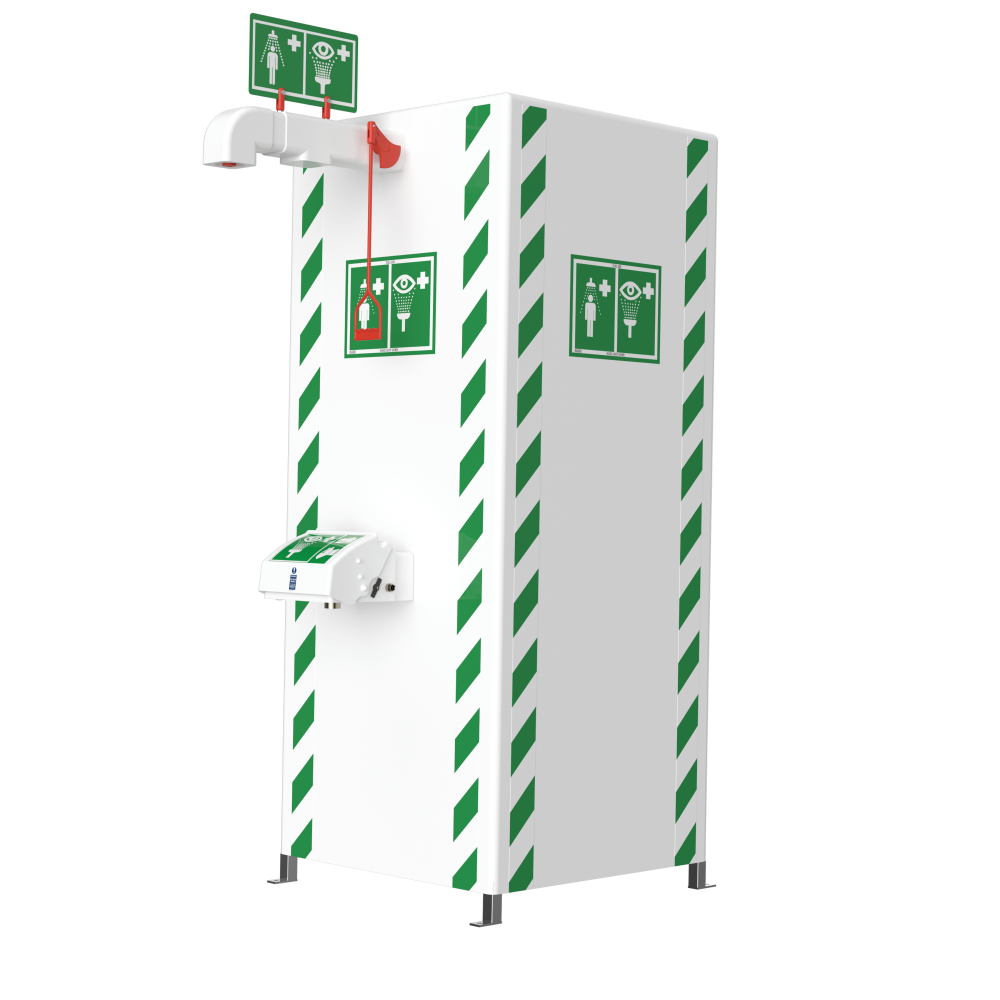 Hughes Temperature Controlled Emergency Safety Shower with Eye/Face Wash
Hughes Temperature Controlled Emergency Safety Shower with Eye/Face Wash
Hughes emergency tank showers are essential in remote environments. Learn more.
Ammonia Safety
When organic matter breaks down, a process known as anaerobic digestion, it releases biogas. This biogas is a methane rich gas that can be burned as a cost-effective heating and electricity solution.
It’s also environmentally friendly. But just because it’s inexpensive and doesn’t harm the environment, doesn’t make it safe. Anaerobic digestion also produces ammonia – a highly corrosive substance to skin. Upon contact with the skin the affected area must be flushed with a large amount of water for at least 15 minutes, at a temperature of between 77 and 86° F (25 and 30° C).
Hughes temperature-controlled emergency safety showers are ideal where ammonia is present. They can maintain the water within this temperature range. If needed, they can also be used to supply heated water to another nearby safety shower. In addition to temperature-controlled emergency showers, Hughes also provides stainless-steel pipework to combat corrosion and improve durability.
Sumgait Chemical Industrial Park
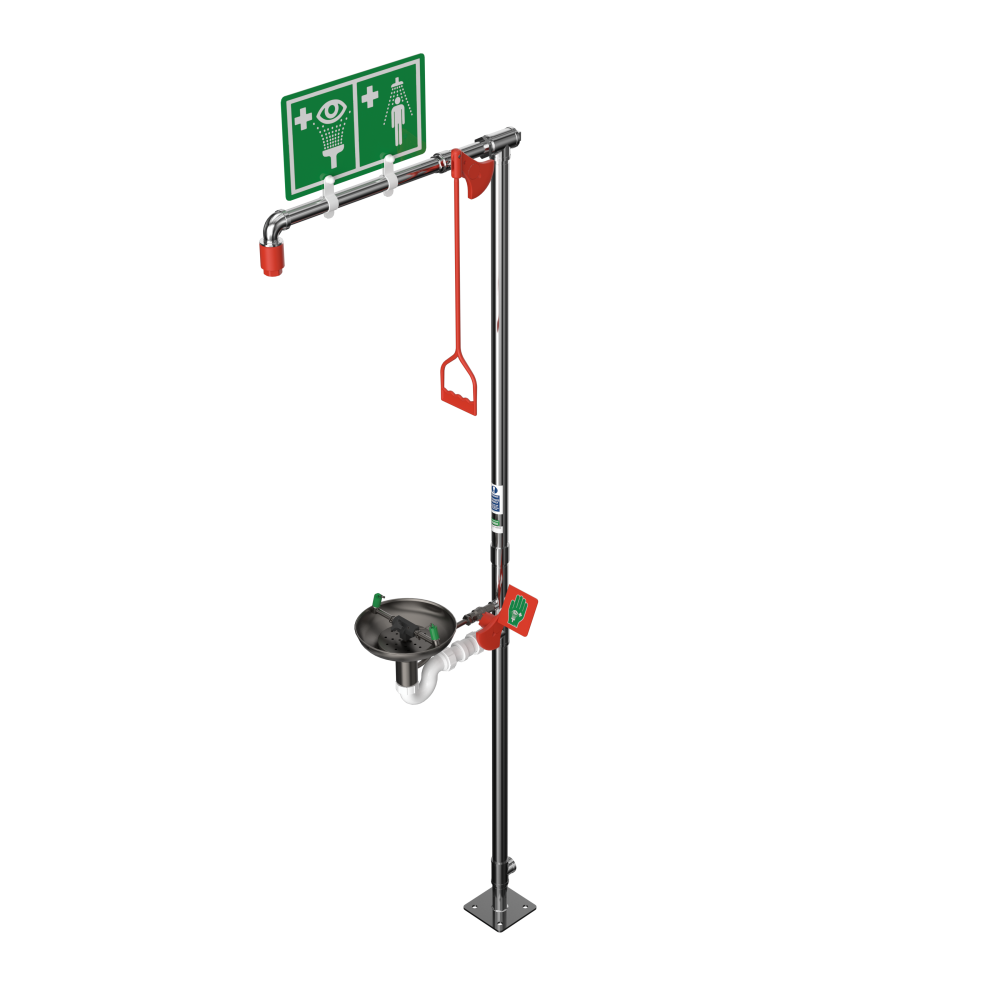 Hughes Floor Mounted Indoor Unheated Safety Shower with Eye/Face Wash
Hughes Floor Mounted Indoor Unheated Safety Shower with Eye/Face Wash
The first polypropylene plant of its size in Azerbaijan in more than 40 years, the Sumgait Chemical Industrial Park was established to accelerate economic development within the country. At nearly 475 acres, the industrial infrastructure would be producing approximately 330.7k tons of product each year.
The State Oil Company of the Azerbaijan Republic (SOCAR) Polymers were looking for a safety shower solution that would be compatible with the extreme temperature fluctuations in the country’s climate. The Hughes team worked with the Sumgait Engineering Procurement Contractor, to provide a customized solution – floor mounted indoor unheated emergency safety showers with open bowl stainless steel eye/face wash units (model 18GS/85G). This combination unit features a dual standpipe recirculating system to reduce the risk of overheating or freezing.
The units also met ANSI’s tepid water requirements and an orifice plate was integrated to ensure a controlled and continuous flow of water through the standpipe – in any condition. In addition to the customizations, the Hughes team specified project specific GO switches complete with cast aluminum EXD junction boxes to meet the Hazardous Area ATEX electrical requirements.
Finally, Hughes applied a corrosion resistant paint to ensure the units would be suitable for the range of chemicals on site.
Contact Hughes Safety Showers Today to Meet Emergency Shower Requirements
Hughes offers an assortment of emergency safety showers and eye wash stations to comply with OSHA and ANSI requirements.
Click here to see our available products.
Contact us to receive expert advice for your safety shower installation.
References:
- Occupational Safety and Health Administration. OSHA Penalties
- Hughes Safety. Safety Considerations at Anaerobic Digestion Plants
- Hughes Safety. Customised Emergency Safety Shower Solution for Extreme Azerbaijan Climate





